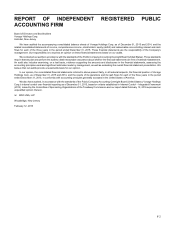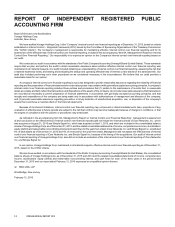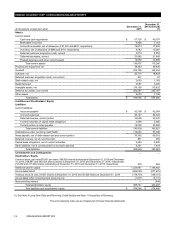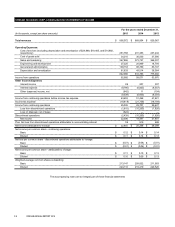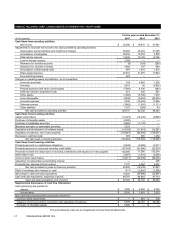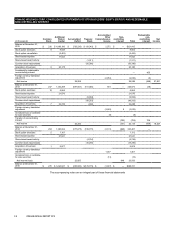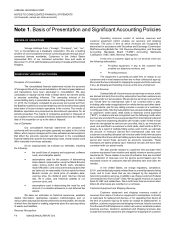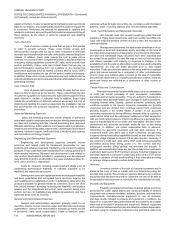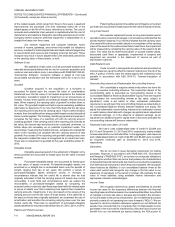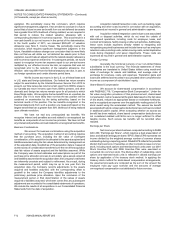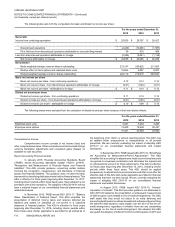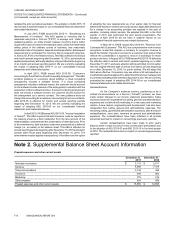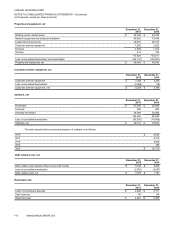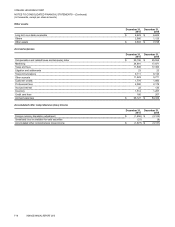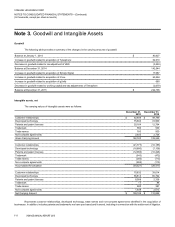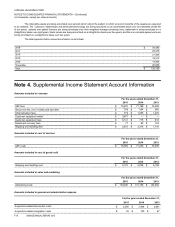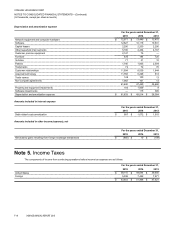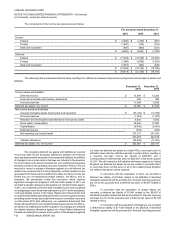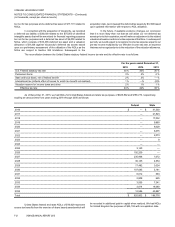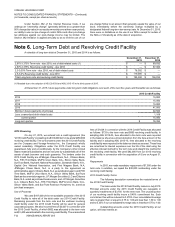Vonage 2015 Annual Report Download - page 72
Download and view the complete annual report
Please find page 72 of the 2015 Vonage annual report below. You can navigate through the pages in the report by either clicking on the pages listed below, or by using the keyword search tool below to find specific information within the annual report.VONAGE HOLDINGS CORP.
NOTES TO CONSOLIDATED FINANCIAL STATEMENTS—(Continued)
(In thousands, except per share amounts)
F-12 VONAGE ANNUAL REPORT 2015
expiration. We periodically review this conclusion, which requires
significant management judgment. If we are able to conclude in a future
period that a future income tax benefit from our net deferred tax assets
has a greater than 50% likelihood of being realized, we are required in
that period to reduce the related valuation allowance with a
corresponding decrease in income tax expense. This would result in a
non-cash benefit to our net income in the period of the determination.
In the fourth quarter of 2011, we released $325,601 of valuation
allowance (see Note 5. Income Taxes). We periodically review this
conclusion, which requires significant management judgment. In the
future, if available evidence changes our conclusion that it is more likely
than not that we will utilize our net deferred tax assets prior to their
expiration, we will make an adjustment to the related valuation allowance
and income tax expense at that time. In subsequent periods, we would
expect to recognize income tax expense equal to our pre-tax income
multiplied by our effective income tax rate, an expense that was not
recognized prior to the reduction of the valuation allowance. Our
effective rate may differ from the federal statutory rate due, in part, to
our foreign operations and certain discrete period items.
We file income tax returns in the U.S. on a federal basis and
in U.S. state and foreign jurisdictions. Our federal tax return remains
subject to examination by the Internal Revenue Service from 2010 to
present, our New Jersey tax returns remain open from 2008 to present,
our Canada tax return remains open from 2009 to present, and other
domestic and foreign tax returns remain open for all periods to which
those filings relate. We recognize the tax benefit from an uncertain tax
position only if it is more likely than not that the tax position will be
sustained on examination by the taxing authorities, based on the
technical merits of the position. The tax benefits recognized in the
financial statements from such a position are measured based on the
largest benefit that has a greater than 50% likelihood of being realized
upon ultimate resolution.
We have not had any unrecognized tax benefits. We
recognize interest and penalties accrued related to unrecognized tax
benefits as components of our income tax provision. We have not had
any interest and penalties accrued related to unrecognized tax benefits.
Business Combinations
We account for business combinations using the acquisition
method of accounting. The acquisition method of accounting requires
that the purchase price, including the fair value of contingent
consideration, of the acquisition be allocated to the assets acquired and
liabilities assumed using the fair values determined by management as
of the acquisition date. Goodwill as of the acquisition date is measured
as the excess of consideration transferred over the net of the acquisition
date fair values of assets acquired and the liabilities assumed. While
the Company uses its best estimates and assumptions as part of the
purchase price allocation process to accurately value assets acquired
and liabilities assumed at the acquisition date, the Company’s estimates
are inherently uncertain and subject to refinement. As a result, during
the measurement period, which may be up to one year from the
acquisition date, the Company records adjustments to the assets
acquired and liabilities assumed, with the corresponding offset to
goodwill to the extent the Company identifies adjustments to the
preliminary purchase price allocation. Upon the conclusion of the
measurement period or final determination of the values of assets
acquired or liabilities assumed, whichever comes first, any subsequent
adjustments are recorded to the consolidated statements of operations.
We include the results of all acquisitions in our Consolidated Financial
Statements from the date of acquisition.
Acquisition related transaction costs, such as banking, legal,
accounting and other costs incurred in connection with an acquisition,
are expensed as incurred in general and administrative expense.
Acquisition related integration costs include costs associated
with exit or disposal activities, which do not meet the criteria of
discontinued operations, including costs for employee, lease, and
contract terminations, facility closing or other exit activities. Additionally,
these costs include expenses directly related to integrating and
reorganizing acquired businesses and include items such as employee
retention costs, recruiting costs, certain moving costs, certain duplicative
costs during integration and asset impairments. These costs are
expensed as incurred in general and administrative expense.
Foreign Currency
Generally, the functional currency of our non-United States
subsidiaries is the local currency. The financial statements of these
subsidiaries are translated to United States dollars using month-end
rates of exchange for assets and liabilities, and average rates of
exchange for revenues, costs, and expenses. Translation gains and
losses are deferred and recorded in accumulated other comprehensive
income as a component of stockholders’ equity.
Share-Based Compensation
We account for share-based compensation in accordance
with FASB ASC 718, “Compensation-Stock Compensation”. Under the
fair value recognition provisions of this pronouncement, share-based
compensation cost is measured at the grant date based on the fair value
of the award, reduced as appropriate based on estimated forfeitures,
and is recognized as expense over the applicable vesting period of the
stock award using the accelerated method. The excess tax benefit
associated with stock compensation deductions have not been recorded
in additional paid-in capital. When evaluating whether an excess tax
benefit has been realized, share based compensation deductions are
not considered realized until NOLs are no longer sufficient to offset
taxable income. Such excess tax benefits will be recorded when
realized.
Earnings per Share
Net income per share has been computed according to FASB
ASC 260, “Earnings per Share”, which requires a dual presentation of
basic and diluted earnings per share (“EPS”). Basic EPS represents net
income divided by the weighted average number of common shares
outstanding during a reporting period. Diluted EPS reflects the potential
dilution that could occur if securities or other contracts to issue common
stock, including stock options and restricted stock units under our 2001
Stock Incentive Plan and 2006 Incentive Plan were exercised or
converted into common stock. The dilutive effect of outstanding, stock
options and restricted stock units is reflected in diluted earnings per
share by application of the treasury stock method. In applying the
treasury stock method for stock-based compensation arrangements,
the assumed proceeds are computed as the sum of the amount the
employee must pay upon exercise and the amounts of average
unrecognized compensation cost attributed to future services.


